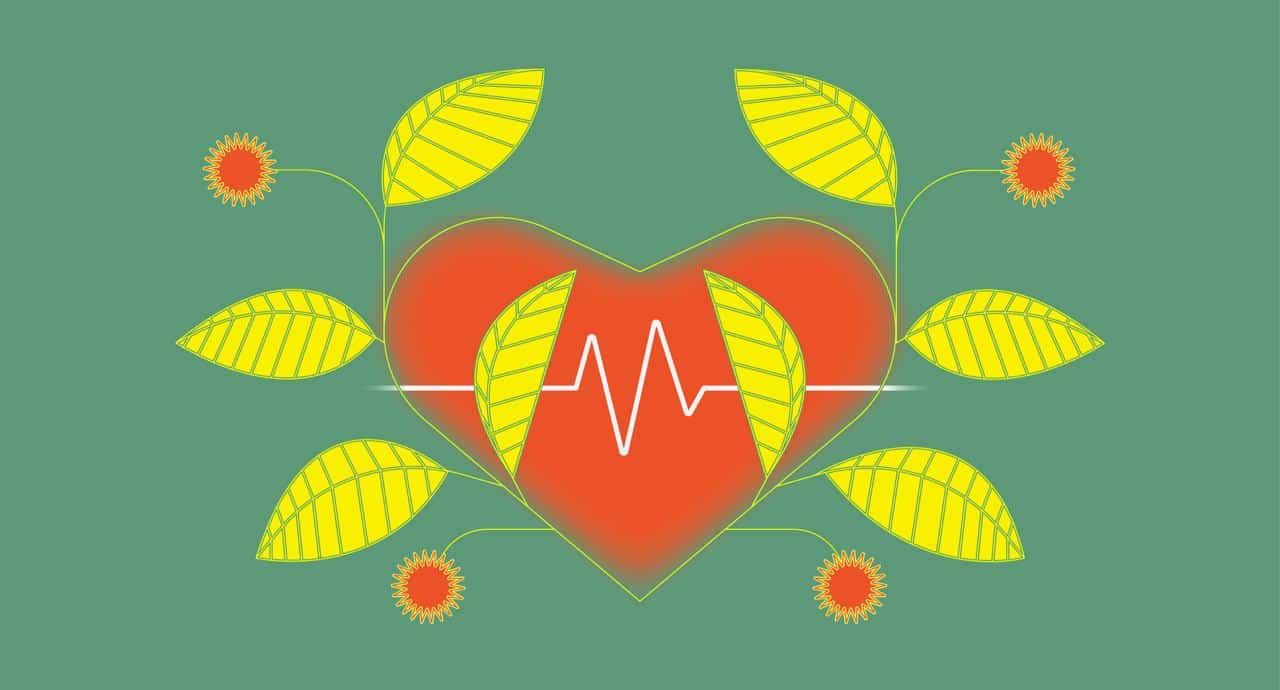Is Kratom Bad for Your Heart?
Kratom could increase the chances of having a heart attack when used in high doses for prolonged periods of time. It’s also more likely to lead to issues in people predisposed to heart disease.
Additionally, heart problems can occur when combining kratom with alcohol, cocaine, or other cardiotoxic drugs.
Kratom is a stimulant, which means it activates the central nervous system. One of the most common symptoms of this is elevated heart rate and temporary spikes in blood pressure. Both of these place additional strain on the heart.
Most people don’t experience any issues when the heart rate and blood pressure increase — but if there are underlying heart conditions, it could cause enough strain to result in damage to the heart or cardiovascular system.
If you already have heart problems, we recommend consulting your physician before trying out kratom. This also applies if you’re taking any type of prescription medication, as kratom could interfere with the compounds within. It’s always better to be safe than sorry.
Kratom & Blood Pressure
The stimulating effects of kratom cause a temporary surge in blood pressure similar to coffee.
People who already have high blood pressure are the most at-risk for negative side effects such as thrombosis, stroke, or heart attack.
Most people won’t experience any adverse reactions to this effect.
Hypertension is defined by a blood pressure reading of 140/99 or higher for adults.
For reference, normal resting blood pressure is 120/80.
If you’ve been diagnosed with hypertension or prehypertension, it’s wise to speak to your doctor before using kratom or any other stimulating supplements (including caffeine).
What are the Signs of High Blood Pressure?
Hypertension often goes unnoticed. It’s estimated that one in three Americans don’t realize they have the condition until later stages of the condition.
The primary signs of high blood pressure include:
- Nose bleeds
- Breathing problems
- Headaches
- Vision trouble
- Blackouts
- Dizziness

What is Kratom?
Kratom (Mitragyna speciosa) is tropical tree species found in the rainforests of Southeast Asia. It’s a close relative of the coffee plant (Coffea arabica).
Although its entry into the U.S. is a modern phenomenon, it’s been used throughout Southeast Asia for centuries. More recently, kratom has entered the Western world. It’s used for a wide range of applications, the most common being pain relief.
There are several ways to consume kratom, including chewing fresh leaves, grinding them into a powder, or even swallowing a kratom capsule.
What Are the Effects of Kratom?
Kratom offers several powerful benefits. The main uses are for alleviating chronic pain and boosting energy and focus. Kratom is also used for its sedative and muscle-relaxant qualities or to help users wean off addictive painkillers or illicit opiates.
Research has shown that kratom’s main benefits include [2]:
- Boosts mood
- Alleviates chronic pain
- Improves focus and concentration
- Boosts energy levels
- Promotes deeper, more restorative sleep
- May alleviate anxiety & depression
It’s important to mention that there are dozens of different strains of kratom. These kratom strains are divided into three categories, including red, green, and white vein strains.
There are also hybrid strains, like yellow or gold kratom.
Each strain category contains several different cultivars, each one with its own distinct effect profile.
For example, red vein kratom is considered the strongest group of sedative and analgesic kratom cultivars.
White vein kratom acts more like a stimulant — useful for boosting energy, focus, and concentration. They’re also the most euphoric strains of kratom.
Green vein kratom and yellow vein kratom sit somewhere in the middle of red and white kratom. Some strains are more stimulating, others more relaxing.
The right strain for you depends on the benefits you want to take advantage of by consuming kratom. Some people have favorite strains, whereas others like to mix and match.
Is Kratom Dangerous?
Kratom, like any substance, can be dangerous if abused. While attempts have been made to ban kratom in the past, the proposed DEA ban was shot down by Congressmen in Washington.
Lethal overdose remains rare from kratom. In fact, in the year 2016-2017, 91 fatal overdoses were reported, but 84 of these instances also involved other harmful substances [3].
The dose of kratom is self-limiting. If you take too much, you vomit — thus preventing you from being able to reach lethal doses.
Additionally, kratom doesn’t affect the respiratory system the way conventional opiates do. It’s this respiratory depression that causes most of the opiate-related overdose deaths.
The main risk comes from mixing kratom with other dangerous substances. Mixing kratom with other opiates could increase the potential for an overdose to occur.
What are the Signs of a Kratom Overdose?
Several signs could indicate a kratom overdose.
Never combine kratom with other opiates, other illicit substances, or alcohol. Most of the effects of combining different substances with kratom are relatively unknown.
Here are some of the main signs of a kratom overdose:
- Nausea
- Irritability
- Hypertension
- Seizures
- Elevated heart rate
- Drowsiness
- Coma
What’s the Right Kratom Dosage for Me?
Figuring out the right kratom dosage can be difficult because, like anything, it largely depends on your size, how much you weigh, your gender, metabolic factors, and more.
Assuming you’re trying out kratom for the first time, begin conservatively with your dosing. Use less than you think to ensure that you are always staying safe.
Most people start with two to four grams of kratom per day. The effects should kick in after 20-30 minutes. If this isn’t enough to feel anything, add an extra gram or two after this period has elapsed.
While it might be tempting to slip in a few extra grams, you increase the likelihood of experiencing an uncomfortable heart rate and hypertension.
Let’s examine how much kratom you should take if you’re experimenting with other mediums.
How Much Kratom Powder Should I Take?
Kratom powder is the most common form of kratom sold online. You can prepare kratom powder by mixing it with some water and knocking it back quickly (it doesn’t taste very good).
The dose range for kratom powder is as follows:
- Low dose (stimulating effects) — 2–5 grams
- High dose (sedative effects) — 5–10 grams
How Many Kratom Capsules Should I Take?
Standard kratom capsules contain roughly a half gram of kratom. For low doses of two grams of kratom, you’ll need to consume four capsules.
When consuming capsules, some users prefer to microdose with them throughout the day to keep the effects going.
Are Specific Kratom Strains Bad for the Heart?
There’s no evidence to show that certain kratom strains are worse for you than others.
Be aware that red strain kratom tends to be stronger, so the risk of taking too much is higher.
Day laborers in Thailand and other Southeast Asian countries, for example, tend to favor the extra-strong Red Maeng Da strain. This strain is potent and provides a big energy boost to help take on the challenges of the day.
White Borneo kratom is another popular kratom strain for energy. It’s a great option for beginners because it isn’t as potent as the Maeng Da varieties. If you’re worried about your heart or hypertension, White Borneo is an excellent starting point for getting into the world of kratom.
Make sure you do your research and be willing to experiment so you can select the right strain for your lifestyle.

Comparing The Top Kratom Brands
| Top Kratom Vendors | Pros | Cons | Coupon Codes & Discounts |
| Kona Kratom | • Extensive product lineup • Fresh batches • Consistently high product potency • Exceptionally fast shipping • AKA certified | • Only ships within the US | Use KRATOMORG for 15% off |
| Star Kratom | • Most Affordable • Selection of rare kratom strains • AKA certified | • Less selection than other popular vendors | Use KRATOMORG for 10% off |
| VIP Kratom | • Specializes in premium kratom • Options for capsules & raw powder for most strains • AKA certified | • Premium products mean premium pricing | Use KRATOM10 for 10% off |
Key Takeaways: Is Kratom Bad for Your Heart?
Both hypertension and an elevated heart rate are common side effects of kratom.
For most people, this poses no direct danger.
However, for people who are already at risk of heart disease or stroke, this could be dangerous.
If you’ve been diagnosed with heart disease or are taking medications to regulate your heart rate or control blood pressure, it’s a good idea to avoid kratom entirely until you can speak to a doctor about the potential risks for damage.
- Schimmel, J., Amioka, E., Rockhill, K., Haynes, C. M., Black, J. C., Dart, R. C., & Iwanicki, J. L. (2021). Prevalence and description of kratom (Mitragyna speciosa) use in the United States: a cross‐sectional study. Addiction, 116(1), 176-181.
- Danielson, M. L., Bitsko, R. H., Ghandour, R. M., Holbrook, J. R., Kogan, M. D., & Blumberg, S. J. (2018). Prevalence of parent-reported ADHD diagnosis and associated treatment among U.S. children and adolescents, 2016. Journal of Clinical Child & Adolescent Psychology, 47(2), 199-212.
- Olsen, E. O. M., O’Donnell, J., Mattson, C. L., Schier, J. G., & Wilson, N. (2019). Notes from the field: unintentional drug overdose deaths with kratom detected—27 states, July 2016–December 2017. Morbidity and Mortality Weekly Report, 68(14), 326.










